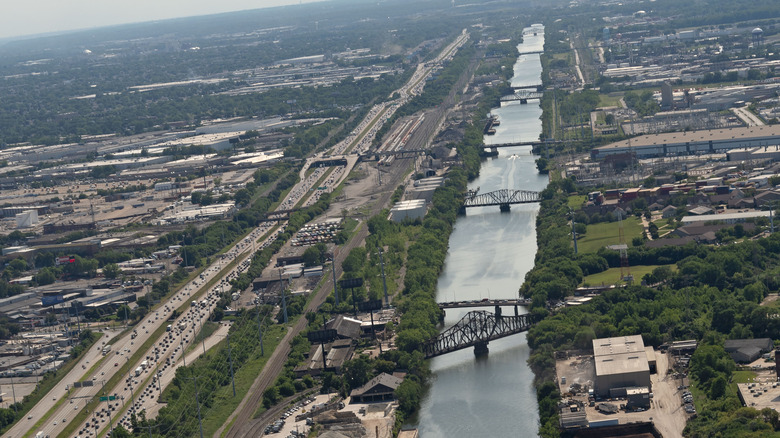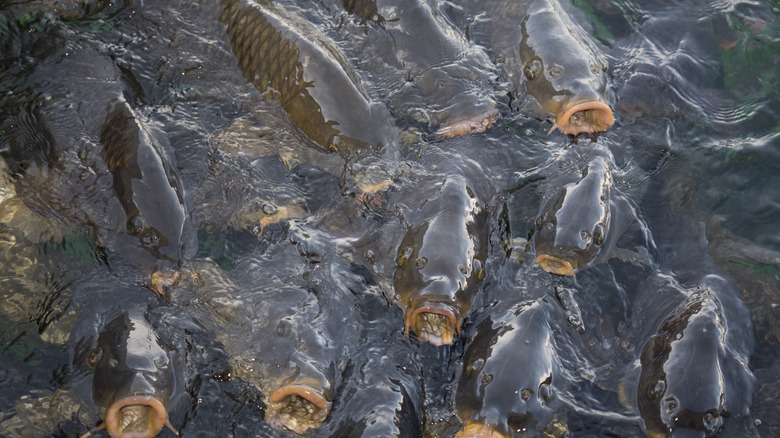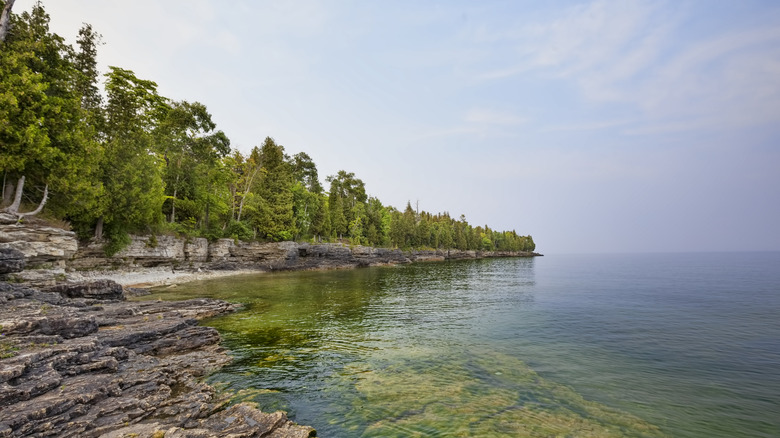The Big Reason Why Chicago Electrifies This Body Of Water
So we all know about the relationship between aphids and ladybugs at this point, right? Aphids destroy plants, so you introduce ladybugs into your garden (omens of good luck in some cultures) to keep the aphid population down. Easy-peasy, right? For ladybugs, maybe, which the University of California says are likely to fly away within 48 hours. But what if they didn't? What if, instead, they stayed and bred and consumed your garden, then neighboring gardens, then every patch of grass in the street, and on and on? Now substitute "carp" for "ladybug" and you can see why the Chicago Sanitary and Ship Canal has a big electrified fence underwater.
It's like this: Asian carp got imported into the U.S. and deposited into southern fish farms in the 1960s to devour algae blooms. But, in a classic case of nature laughing in the face of self-congratulatory bipedal apes, floodwater carried the carp into the Mississippi River. They spread northward and within 20 years made their way through the Ohio, Missouri, and Illinois Rivers, and dozens of tributaries along the way. The "rabbits of the water," as NPR calls them, breed prolifically and basically never stop eating. At this point, they've devoured their way through indigenous fish populations and comprise 90% of the fish in some areas as they make their way closer to Lake Michigan, which connects the Mississippi River with the Gulf of Mexico. So how do we protect the $7 billion-per-year fishing industry of Lake Michigan from carp? A big 'ole electrified fence at a well-placed bottleneck: the Chicago Sanitary and Ship Canal.
A big fish problem
Let's be clear: If carp weren't so big and didn't eat and breed so much, there would be less of a reason to bar them from entering the Great Lakes. But first, when we say "Asian carp," we're referring to any of four distinct carp species. Per the United States Coast Guard, these include bighead, silver, grass, and black carp, and there are detailed response measures for tracking and controlling "invasive" — read: introduced by people — species in the U.S. So yeah, these fish are a big deal, even a threat to ecosystems. As Great Lakes conservationist Joel Brammeier said on NPR back in 2009, "If we don't take the right steps today, we are consigning the Great Lakes to a future as carp ponds."
Carp aren't just a big deal and a big threat — they're also big. Like, physically. The largest Asian carp species, black carp, can reach over 150 pounds per fish, as Oregon State University says. Thankfully, black carp also take the longest to reach sexual maturity, at 6 to 11 years old. Bighead carp, however, can produce offspring at 2 to 3 years old, which makes for a pretty fast generational turnover rate. And did we mention they eat a lot? NPR reports silver and bighead varieties can consume up to 40% of their bodyweight per day. Different carp also prefer different food, which not only threatens other species directly but also endangers their food sources.
A big electric fence solution
The electrified solution to stop the Asian carp population from infiltrating Lake Michigan started way back in 2009. As NPR said back then, 2,300 gallons of toxic Rotenone got poured into the Chicago Sanitary and Ship Canal along 6 miles of its 30-mile stretch. The idea was to kill all the nearby carp to make space for the U.S. Army Corps of Engineers to install its electrified fence. Or as the Invasive Carp Regional Coordinating Committee (ICRCC) calls it: the Electric Dispersal Barrier.
The barrier itself is composed of multiple sections, and doesn't so much as leave electrocuted fish floating in dead heaps in the water as it makes the water too uncomfortable for them to traverse. Different sections pulse different voltages at different rates, like Barrer I releasing 1 volt per inch every 4 milliseconds. So no, don't go falling in the canal. A U.S. Coast Guard Acquisition Directorate report says that you can still be shocked while standing on a boat, though, albeit the chances of this happening are very low — fractions of a percent — for both commercial and recreational vessels.
And for all those savvy river-faring readers out there, you're right: It wasn't always the case that Lake Michigan connected to the Mississippi River through the Chicago Sanitary and Ship Canal. That's because the channel itself is a man-made shortcut finished way back in 1900. Now it's a fix to another man-made problem.


